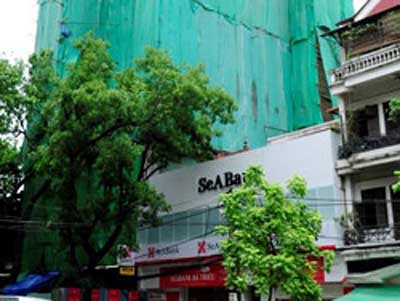
|
| A building on Ba Trieu Street violates building and design commitments. — Photo: Tin Tuc |
The authorities have so far demolished 600 illegal buildings and requested the demolition of 310 others, while 790 projects are being investigated.
Tran Viet Ngon, the department's deputy chief inspector, said numerous buildings did not have construction permits in the suburban districts of Tu Liem, Thanh Tri, Soc Son and in former Ha Tay Province that was merged with Ha Noi in 2008, in particular Quoc Oai, Hoai Duc, Phu Xuyen and Thach That districts. He said that in each commune there was only one construction inspector responsible for overseeing local projects.
"Moreover, inspectors and even commune officials had turned a blind eye to a number of violations," he said.
He said that construction firms were either unaware they were breaking building regulations or were wilfully ignoring them.
Dinh Doan Loi, who owns a safety deposit box manufacturing company in Hoai Duc District's Kim Chung Commune, said his workshop used to be in his house but that he had moved it to a rural area to expand production and reduce traffic disruption in his residential neighbourhood.
Meanwhile, Nguyen Huu Cuong, the commune People's Committee chairman, said numerous local people had set up businesses in their homes.
"The need to expand production has forced company bosses to relocate their businesses to agricultural areas," he said, adding that under the city's master development plan, it was impossible for the commune to find land for local businesses to develop.
Local authorities had fined violators for using their residential addresses as businesses, but Cuong said the practice had continued. "What else can we do?" he said.
Meanwhile, in inner-city areas, most building violations involved misuse of construction permits, Ngon said.
The most common violation involved exceeding the number of permitted storeys. The most serious offences have taken place on construction sites at 55A-55B-55D Ba Trieu Street, 135-137 Bui Thi Xuan Street and 19 Trieu Viet Vuong Street.
He said construction firms were eager to expand floor space in expensive localities, where each square metre can cost upwards of VND40-80 million (US$2,000-4,000).
Meanwhile, under current regulations, the biggest fines that can be meted out for building violations is VND500 million. However, that figure is expected to double under new draft regulations being considered, according to Ngon.
He also attributed many of the violations to a lack of detail in land-use, construction development and urban design plans which help identify non-residential areas where construction of office buildings and factories can take place.
"As a result, in many cases, investors had submitted applications for a construction permit and authorities, including the Construction Department or People's Committees in communes/wards and districts, had granted permits based on very general regulations," he said.
Moreover, some existing regulations were impractical, he said.
For example, under a national standard for construction passed in 2008, on a 100-square-metre plot of land, the investor is required to leave 20 per cent as open space. In fact, however, the whole area is used for housing or running a business. "They are happy to violate the regulation," he said.
Regulations also state that investors must inform their local authority about construction plans seven days before building work commences. However, the number of inspections that must be carried out had not been regulated, Ngon said.
"Thus, inspectors visit construction sites many times to ‘annoy' investors or in some cases only make a few visits," he said.
Ngon cited the example of the under-construction building at 55A Ba Trieu Street. He said inspectors made a number of visits to the site until its 7th floor was completed, and then stopped. Additional floors have since illegally been added and the nine-storey building now has 13 floors.
"It's a management problem," he said, adding that periodic inspections should be made. Construction work should only be allowed to proceed if everything is in order.
"If we work like this, violations will be detected earlier and time and money will be saved," he said.
Ngon also said local agencies needed to co-operate more fully with one another. For example, power should be cut to a site where building work had been halted because of construction violations, he said.
Under current regulations, utility companies must cut water and electricity to illegal construction works or risk a fine of VND20-30 million, Ngon said.
At a construction management meeting in the city last week, Politburo member and secretary of the Ha Noi Party Committee Pham Quang Nghi urged better public awareness of construction regulations and called for local residents to be made fully aware of proposed planning projects.
He also suggested strengthening leadership among administration agencies responsible for construction management, while increasing monitoring, promoting administrative reform and increasing co-ordination among different sectors.
Nguyen The Thao, the Ha Noi Municipal People's Committee chairman, said lax management of construction projects had resulted in increasing numbers of building violations. He said the local authority would examine and punish relevant parties including investors and construction officers if negligence or wrong-doing was found.
VietNamNet/Viet Nam News